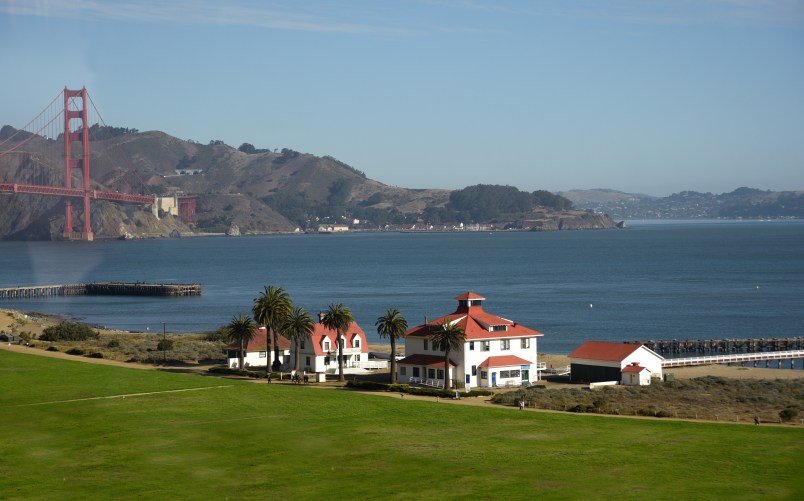This article is part of TPM Cafe, TPM’s home for opinion and news analysis.
Much has been made of the out-of-work, Midwestern factory worker as a symbol of American decline. But just as symbolic is a gleaming 1.6 mile stretch of road at the northern tip of one of the country’s most elite locales, San Francisco, California.
The newly constructed Presidio Parkway, which replaces one of Franklin Delano Roosevelt’s New Deal projects, is a hulking chunk of concrete snaking through the eucalyptus trees and tidal marsh of the Presidio, first inhabited by the Ohlone people and now a public park and national historic landmark. Though lauded for its innovative design, the project has a Trumpian twist — it was paid for through smoke and mirrors.
Back in 2010, amid the mortgage crisis, then-Gov. Arnold Schwarzenegger’s administration raised funding for the project by circumventing the traditional method of financing for state and local governments, tax-exempt bonds. The California Department of Transportation, known as Caltrans, signed a so-called “public-private partnership,” effectively borrowing nearly half a billion dollars from a group of European private investors who would be responsible for designing, building, and maintaining the parkway for 30 years. Schwarzenegger branded the project as a win-win for everyone, calling it a “shining example” of the benefits that come with introducing competition into government services.
Yet what happened next has become all too common in experiments using public-private partnerships to fund infrastructure. While the road in San Francisco is complete, the environmental work, landscaping, and other contract tasks are now nearly three years behind schedule. Meanwhile, costs have skyrocketed over budget, eating up an extra $208 million.
Though Californians will bear the brunt of those issues, the rest of the country should take notice. Federal infrastructure investment has fallen by half over the last 35 years, placing a greater burden on state and local tax revenue. While corroding pipes in Rust Belt cities like Flint, Michigan, and collapsing dams have gained headlines, the use of public-private partnerships is just as alarming.
A growing industry of multinational banks, construction firms and water corporations is peddling expensive capital to elected officials from Maryland to the Bay Area. The Presidio Parkway was paid for by the French financial firm Meridiam and the German construction giant Hochtief, which has also shown interest in bidding on Trump’s border wall. As federal funding shrinks, cities and states are increasingly turning to such private investors to finance infrastructure needs. And because decades of conservative propaganda has made raising taxes on corporations and the wealthy tough political sledding, many a governor and mayor—including Democrats—are regurgitating the industry line that public-private partnerships can deliver “innovative” projects faster and cheaper than traditional procurement.
But if the Presidio Parkway is any indication — as well as infrastructure projects in Indiana, Texas, and Denver — public-private partnerships are anything but innovative. The initial math Caltrans used to justify using expensive private capital didn’t bear out. Sure, California taxpayers would be paying investors a 14.2 percent return rather than the bargain-basement interest rate on tax-exempt bonds, but they’d “achieve greater schedule and budget certainty,” they claimed.
Yet, the California Transportation Commission has since approved eight supplemental funding requests for the project. Yes, San Francisco has a shiny new road to match the Golden Gate Bridge it connects to, but was it worth it? How many aging bridges, water pipes, or dams could be fixed with all that money going to investor profits for the next 30 years? And what about that extra $208 million?
Given the enormity of the country’s infrastructure deficit, every dollar counts. More than half of public school buildings need funding to be brought up to good condition. There are more than 15,500 high-hazard dams nationwide. Public transit is wearing out and sparse as it is, with over 85 percent of Americans either driving alone or carpooling to work. Some 21 million people lack access to high-speed broadband internet.
What’s really needed is more direct, federal investment—and lots of it. The American Society of Civil Engineers says $4.5 trillion is needed by 2025 to fix the country’s roads, bridges, dams, airports, schools and more. Sure, Trump and the GOP deserve some blame — the administration has floated multiple infrastructure plans since being in office that include incentivizing more public-private partnerships and even cutting spending. But the federal government has long sidestepped the crisis.
If nothing changes in Washington, here’s the future of America: congested, crumbling and decaying infrastructure in rural and poor urban areas, and glimmering mega-projects in places where residents can afford the healthy premiums demanded by financiers. A land of millions left behind, peppered by a few Potemkin villages built with multinational capital and deceit.
Jeremy Mohler is a writer, meditation teacher, and communications director of In the Public Interest, a national think tank that studies public goods and services.






